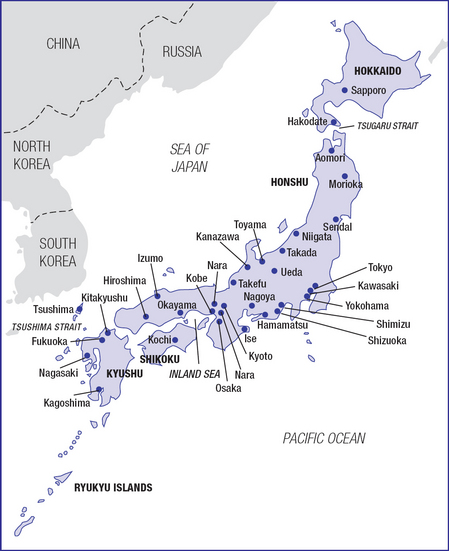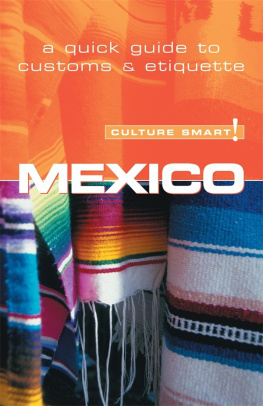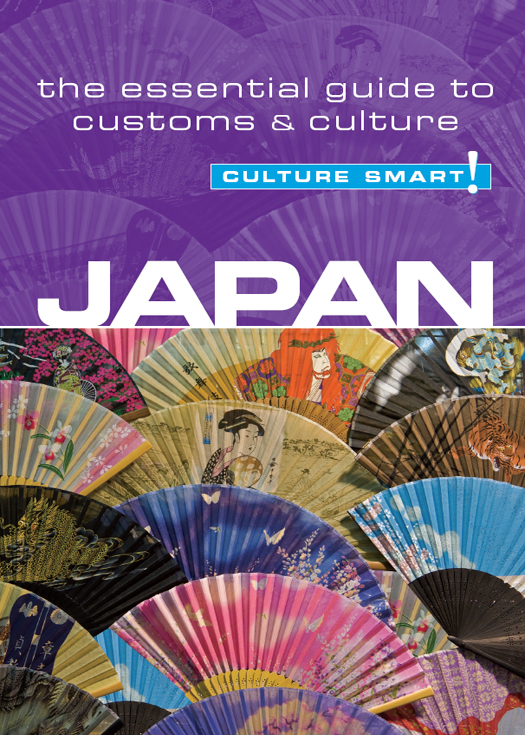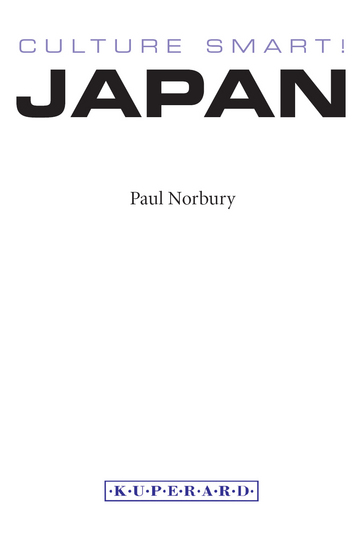eISBN: 978-1-85733-615-3
British Library Cataloguing in Publication Data
A CIP catalogue entry for this book is available from the British Library
Copyright 2003, 2011 Kuperard
Revised and updated edition 2011
All rights reserved. No part of this publication may be reprinted or reproduced, stored in a retrieval system, or transmitted in any form or by any means without prior permission in writing from the publishers.
Culture Smart! is a registered trademark of Bravo Ltd
First published in Great Britain 2003
by Kuperard, an imprint of Bravo Ltd
59 Hutton Grove, London N12 8DS
Tel: +44 (0) 20 8446 2440 Fax: +44 (0) 20 8446 2441
www.culturesmart.co.uk
Inquiries:
Distributed in the United States and Canada
by Random House Distribution Services
1745 Broadway, New York, NY 10019
Tel: +1 (212) 572-2844 Fax: +1 (212) 572-4961
Inquiries:
Series Editor Geoffrey Chesler
Cover image: Traditional Japanese fans iStockphoto.com
Photographs on
Images reproduced under Creative Commons Attribution-Share Alike 3.0 Unported license: Morio.
Reproduced under Creative Commons Attribution-Share Alike 2.0 Generic license: Paul Synnott.
On , Creative Commons Attribution-Share Alike 2.0 Austria license: Harald Hofer.
v3.1
About the Author
PAUL NORBURY has been closely associated with Japan as publisher, editor, and author since the early 1970s, when he launched the award-winning Tsuru magazine for Japan Airlines, the best of which was published in book form as Introducing Japan. He also co-edited with Geoffrey Bownas Business in Japan: A Guide to Japanese Business Practice and Procedure. In the 1980s he published Euro-Asia Business Review for the Euro-Asia Centre, INSEAD, Fontainebleau, and established the Japan Library. In 1990 he founded the quarterly Japan Digest, and in 1996 a new imprint, Global Oriental.
The Culture Smart! series is continuing to expand.
For further information and latest titles visit
www.culturesmart.co.uk
The publishers would like to thank CultureSmart!Consulting for its help in researching and developing the concept for this series.
CultureSmart!Consulting creates tailor-made seminars and consultancy programs to meet a wide range of corporate, public-sector, and individual needs. Whether delivering courses on multicultural team building in the USA, preparing Chinese engineers for a posting in Europe, training call-center staff in India, or raising the awareness of police forces to the needs of diverse ethnic communities, it provides essential, practical, and powerful skills worldwide to an increasingly international workforce.
For details, visit www.culturesmartconsulting.com
CultureSmart!Consulting and CultureSmart! guides have both contributed to and featured regularly in the weekly travel program Fast Track on BBC World TV.
contents
Note
At the time of writing, the earthquake and tsunami of March 2011 had just taken place, and the threat of meltdown and radiation leakage from the damaged nuclear reactors at the Fukushima I Nuclear Power Plant was still being grappled with. For more detailed information see .
Map of Japan

introduction
At the end of the thirteenth century, Marco Polo, observing the country he called Cipangu, wrote about the Japanese as being idolaters who subordinate themselves to no other statemeaning they were a strange, isolated, and very different people. In the twentieth century, the economist G. C. Allen described Europeans who do business with the Japanese as being often baffled and sometimes exasperated in their encounters. While acknowledging Japans distinguished place among the industrial nations, he remarked: Yet, among her people, the springs of action, the motives that govern conduct, frequently seem incomprehensible to men brought up in the West.
This book sets out to provide a concise introduction to this unique country, its people, and way of life, illuminating those issues, actions, and motives that continue to baffle what the Japanese used to refer to as the outside world. Equally, it offers a good guest guide, with useful advice on what to expect and how to behave in different social circumstances.
We explore the Japanese cultural scene, from deep-seated attitudes and values to the ever-important world of business, identifying change where it is taking place and highlighting the many traditional customs and practices that still feature in Japanese life. This traditionalism can appear paradoxical when set against Japans stunning city architecture and ultra-modern transportation and communications systems, or the sight of Japanese youth following Western fashion and style in Hibiya Park, Tokyo.
Although no longer Asias new giant, and despite the economic, political, and cultural challenges it faces today, Japan remains a significant world player, both as an economic power (third in the world after China), and as a catalyst for change and innovation. It has always had a remarkable capacity to adapt to changing circumstances, from the unification that brought about the cultural flowering under the Tokugawa Shogunate (16031868) to the recovery after the Second World War, which in one generation projected it from a state of collapse to the status of industrial and economic superpower. With the advent of new players on the world stage, not least China and India, Japan is once again having to adapt to new and unusual circumstances and embrace significant change, both within and without.
Culture Smart! Japan aims to broaden your perception and understanding of the Japanese people, to equip you to avoid the pitfalls of cultural misunderstanding, and to make your visit to this important, dynamic, and creative society a rich and mutually rewarding experience.
Key Facts
| Official Name | Nippon | Japan |
| Capital City | Tokyo | Population, including suburbs: 28 million |
| Main Cities | Osaka, Nagoya, Kobe, Yokohama, Fukuoka, Sapporo |
| Area | 143,660 square miles (372,079 sq.km.) | Japan uses the metric system. |
| Climate | Moist temperate |
| Currency | Yen | Paper: Yen 10,000, 5000, and 1000 Coins: Yen 500, 100, 50, 10, 5, and 1 |
| Population | 127 million |
| Ethnic Makeup | (Just under) 99% Japanese; (just over) 1% others | Other principal nationalities: Korean, Chinese, Brazilian |
| Family Makeup | Average family size is 2.8 people. Birthrate: 1.3 | In opinion polls, over 80% of Japanese perceive themselves as middle class. |
| Language | Nihongo (Japanese) | Principal other languages taught in schools: English, French, Spanish, and German |





